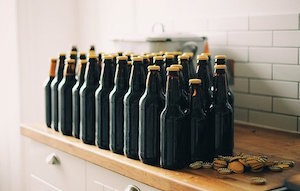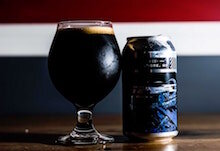What are the healthiest beers?
Darker beers, such as stouts and porters, and extra hoppy beers, such as DIPAs and Imperial IPAs are the healthiest, along with Trappist beers and spontaneous fermented beers, such as Lambics and Gose.
Light to moderate consumption of beers is associated with the prevention of type-2 diabetes, osteoporosis, coronary heart disease, hypertension, dementia, and many types of cancer. Beer contains antioxidants, minerals, and vitamins, including several important nutrients that are most easily digestible in beer form.
beer & antioxidants
“Approximately 80% of beer phenols are
derived from malt and about 20% from hops”
In 1991, the TV show 60 minutes aired an episode that discussed the fact that the French people, despite having a diet high in saturated fat and smoked like…well the French, only had 1/4 of the rate of heart disease compared to the Americans. This became known as the French Paradox since the episode concluded that greater levels of red wine consumption were the reason for the reduced rate of heart disease. This 60 Minutes episode and the subsequent follow-up episode in 1995 formed the basis for the belief that red wine is the healthiest alcoholic beverage.
The total amount of usable antioxidants (phenolics) in beer and wine is comparable, despite red wine having a higher concentration of phenolics. Antioxidants in beer have superior absorption compared to the ones found in wine and are of different varieties.
beer taste & antioxidants
“Antioxidative activity is a significant aspect of beer quality”
Barley and hops are responsible for the majority of antioxidants found in beer. “Approximately 80% of beer phenols are derived from malt and about 20% from hops.” These readily absorbable phenolic compounds in beer originate from barley and hops and are thoroughly metabolized by our bodies.
How do you know if the beer your drinking is loaded with this special antioxidant (AO) compounds?
Beers rich in AOs have more color, bitterness (hoppy flavor), richer flavors & aromas, and good foam (head) stability. Most craft and artisanal beers are filled with a rich and diverse AO profile, since more hops, grains, and yeast strains are used, with less filtration and minimal processing.
“Antioxidative activity is a significant aspect of beer quality”, which means you can literally taste the AOs. The most abundant phenolic acids in beer are gallic acid, ferulic acid, and syringic acid.
A 2010 study from the University of Belgrade in Serbia studied 23 beers that were available from a local shop and tested their antioxidative activity. What did these beer researchers find?
Dark beers had the highest levels of phenolics
Strong beers had the 2nd highest levels
Standard beers, which is a polite way of saying mass-produced light beers had the least amount of AOs of the alcoholic beers
Non-alcoholic/near beers had the lowest amounts of antioxidative activity
beer as a free radical scavenger
Beer has numerous antioxidants that have free radical scavenging ability. What is a free radical scavenger? According to the Cancer.gov website, a free radical scavenger is:
“A substance, such as an antioxidant, that helps protect cells from the damage caused by free radicals. Free radicals are unstable molecules that are made during normal cell metabolism.”
Catechin and ferulic acids from barley and malt have high free radical scavenging activity. Since both of these acids are antioxidants, the beers that seek and destroy free radicals the best are once again the dark beers.
Simple free radical scavenger equation: (worst) Near beer <lager<strong <dark beer (best)
So what are the healthiest beers?
I have spent countless hours combing through the research and have looked over academic studies that have tested over 100 different beers for total phenols, total flavonoids, antioxidant activity, and free radical scavenging activity, and here is my list of the healthiest beers, and styles, in no particular order:
trappist & abbeys
Trappist beer is probably the most famous of the Belgian beers. The Westvleteren XII is a Belgian Trappist quad and is regularly ranked as the best beer in the world. The brewing and commercialization of this beer are still controlled by Trappist monks, which originated in the 17th century in the abbey of La Trappe, in Normandy.
Currently, there are only 14 Trappist abbeys that brew and sell beer, and all are members of the International Trappist Association, which was created in 1997 to preserve the authenticity of Trappist beers.
To be labeled as a Trappist beer
To be labeled as a Trappist beer, the beer must be made within the walls of a Trappist monastery or in the immediate vicinity, either by monks or under their direct supervision, and profits should be used for the monastic community or charity.
Abbey beers, like Leffe, are produced in the styles made by the Belgian Trappist monks but are NOT actually brewed within the walls of the monastery.
Leffe Brown (Brune) and Leffe Blonde were tested in almost every study since most of these studies took place in European laboratories, where this beer is abundant. Leffe Brown was consistently at or near the top for total antioxidants and the ability to scavenge free radicals.
Is Leffe made by monks, today?
The abbey Notre Dame de Leffe was founded in the 12th century. Today, Leffe is brewed at the ABInBev brewery in Leuven, Belgium…..so the answer is no.
L’Abbaye Notre-Dame de Leffe or simply the Abbey of Notre-Dame (Image Source: Flickr)
Silicon: Traps & Abbeys:
All beers have significant amounts of silicon, which plays an essential role in bone mineral density, and promotes synthesis & development of connective tissue. This silicon is one of the main reasons that quality beer is considered an anti-osteoporosis functional beverage. Trappist and Abbey beers contain extraordinary concentrations of silicon, due to longer bottle conditioning time, and being unfiltered.
Josh Austin, Certified Cicerone recommendations:
Sugar Creek Brewing Co. - Belgian Double
Allagash Brewing Company - Curieux
Brouwerij Westvleteren - Trappist Westvleteren 12 (XII)
Brasserie de Rochefort - #10
Kriek is a Lambic with Cherries added
lambic beers
Traditional lambic sour beers are produced through spontaneous fermentation. This means that no starter culture is used, and the wort is naturally boosted from the environmental air. The fermentation and maturation process takes place in oak/chestnut casks and lasts between one to three years.
In traditional Belgian lambic beers has four phases, with each phase imparting specific micro-organisms or microbiota. Lambics have more in common with wines than your classic beer.
Recently, sour beers have become commonplace at craft breweries, and have for some, bridged the gap from classic beers to wines. Gueuze, faro, fox lambic, Vieux Lambic, and fruity beers such as Framboise, druiven, and Kriek all have a lambic base.
Gueuze, like Champagne, both use a secondary fermentation period in the bottle. The Method Champenoise was first used in the 18th century by Benedictine monk Dom Pérignon. Gueuze is made by blending young and old lambics, then bottling and waiting for the second fermentation.
So are lambics the healthiest beer?
Maybe…Lambics have healthy amounts of probiotics from the unique spontaneous fermentation process, which confer benefits to your digestive system. Also, these sour beers have different antioxidant compounds, due to the different brewing techniques. Lambics are a healthier option than many beers…..are they the healthiest…..maybe.
Josh Austin, Certified Cicerone recommendations:
Brasserie Cantillon - Lambic
Brouwerij 3 Fonteinen - Oude Lambik
Jester King Brewery - SPON
Trinity Brewing Company- 7-Day Golden Sour
Brouwerij Boon - Oude Geuze Boon
STOUTS & PORTERS
Of all the beer styles, generally, stouts and porters have the highest antioxidant activity and concentration. In studies, beers containing higher levels of roasted malt had the most antioxidant content.
Stouts and porters are beer styles that feature dark roasted malts in the mash bill giving the beer a roasted chocolate and coffee aroma and flavor. Different styles of stouts and porters include dry stouts, milk stouts, oatmeal stouts, imperial and Russian imperial stouts. Imperial and Russian Imperial Stouts are considered big beers that are typically 8-12% alcohol and include more malt and hops in the brewing process.
High alcohol beers are found to have the most antioxidant activity. This is because the increased alcohol makes the phenols more digestible and more malt is needed to brew these big beers. Porters and stouts significantly inhibit protein glycation, which plays a role in the aging process and diabetes.
Guinness Extra Stout
Guinness Extra Stout (GES) is one of the lower strength beers that rank high on numerous health measures in all the studies. In European markets, Guinness is between 4.1 - 5% ABV and in many of the studies was tested at 4.95% ABV.
Guinness Extra Stout in study after study ranks in the TOP 3 in both total phenols and flavonoids and is also one of the highest-rated beers for free-radical scavenging ability. The GES is the closest to the Guinness Superior Porter, which was the original beer brewed by Arthur Guinness II (son of Arthur Guinness).
(Image Source: Flickr)
Interesting Guinness note: Guinness Foreign Extra Stout is 7.5% ABV, and was first brewed in 1802. The Guinness Draught in cans was first offered in 1986, thanks to the creation of their nitrogen release widget.
Interesting side info: In 1817 Daniel Wheeler invented the roasting kiln, this was revolutionary as it allowed the beer industry to roast malts with different characters, allowing for malts to be roasted from lightly toasted to black malt, therefore allowing them using a base pale malt and then adding various levels of roasted malts which create the complexity and richness of flavors from toasted nuttiness to chocolate and coffee.
Josh Austin, Certified Cicerone recommendations:
Anchor Brewing - Anchor Porter
Moody Tongue Brewing Company - Caramelized Chocolate Churrow Baltic Porter
Left Hand Brewing - Milk Stout
Great Divide Brewing - Yeti Imperial Stout
North Coast Brewing - Old Rasputin Russian Imperial Stout
PALE ALES & IPAS
Pales Ales originated in England with an amber color and bitter finish. They feature crisp, spicy, and herbal flavors and aromas from the English hops.
IPAs or India Pale Ale is a traditional English style pale ale with extra hops. This beer was brewed in colonialism times, as the extra hops allowed it to travel long distances without spoiling.
In 1980, Sierra Nevada Brewing Company created the first American Pale Ale, by loading up a pale beer with American Cascade Hops, this created a beer with pine, resin, grapefruit and citrus aromas. Bringing about a new style that is the basis for all other American Pale Ales and American IPAs to follow.
In 1994, the brewmaster Vinny Cilurzo created the first Double India Pale Ale (DIPA). Vinny now owns and operates Russian River Brewery and their Pliny the Elder is one of the most sought after DIPAs on the market today.
Numerous studies have shown that beer may counteract osteoporosis, since humulone, which is found in hops, strongly inhibits bone resorption. Some of the world's most hop-forward beers are Pale Ales and IPAs. Humulone is both an antioxidant and anti-inflammatory.
Josh Austin, Certified Cicerone recommendations:
Melvin Brewing - Hubert Pale Ale
The Fuller's Griffin Brewery - Fuller India Pale Ale - English IPA
Burial Beer Co. - Surf Wax IPA
Pipe Works Brewing Co. - Ninja vs Unicorn DIPA
Dog Fish Head Craft Brewering - 120 Minute Imperial IPA
Other Half Brewing - Triple Purple Chroma - Imperial IPA
gose
Gose was first brewed in Goslar, Germany, over 1,000 years ago, and was a spontaneous fermented. Gose was thought to be lost in the 1800s as a beer style but renewed interest as brought about a resurgence in the style.
Today, this beer is typically brewed with a heavy wheat base with salt and coriander added along with lactobacillus to produce a sour or tart beer. Many craft breweries also add fruit to this beer before or after fermentation to give it a unique flavor twist.
Berliner Weisse is also another lactobacillus soured wheat beer which was traditionally served with woodruff or raspberry syrup to back-sweeten it at the table.
“studies suggest that Lactobacillus might also be useful for preventing metabolic syndrome, reducing anxiety and depression, reducing atopic disease, and preventing bacterial vaginosis.”
Lactobacillus is a probiotic bacteria, which research suggests is good for digestion and is found in such foods as sauerkraut, miso, and kimchi, all foods known for their gut health abilities.
If your looking for a beer lower in alcohol that still provides great health benefits then Gose or Berliner Weisse is it. Traditionally these beers have around 2.5-4% ABV, which makes this beer lower in octane then most of the beers you will find at your local microbrewery.
Interesting Info: In historical times, Gose was reputed to greatly improve sexual potency.
Sour beer brewing notes:
In conventional beer brewing, the presence of lactic acid bacteria (LAB) is usually associated with beer spoilage. However, in Lambics, Berliner Weisse, and Gose, or other sour beer styles, these beers are brewed by introducing LAB or other wort-souring microbes during the production process. Lactobacillus is the largest and most diverse group of lactic acid bacteria species.
Josh Austin, Certified Cicerone recommendations:
Bayerischer Bahnhof - Leipziger Gose
The Bruery Terreux - Goses Are Red
Tarboro Brewing Co. - Seed Spitter Watermelon Gose
Bear Republic Brewing Co. - Tartare (Berliner Weisse)
Create Comforts Brewing Co. - Athena (Berliner Weisse)
craft beer
At the time of Prohibition, there were 1179 independent breweries in the United States. Once Prohibition started on January 1st, 1920 that number dropped to zero….overnight. In 1978, President Jimmy Carter signed into law H.R. 1337, which is more commonly known as the Home Brew Act. Presently, the United States has over 7,000 microbreweries, nano-breweries, and brewpubs.
Craft and artisan breweries use premium and authentic ingredients and offer unique brews that are only offered at the microbrewery. Many craft breweries are blending traditional beers with regional ingredients, which create a true artisan beer and add extra nutritional profiles.
Some nutrition experts consider craft beer to be a functional beverage since beer imparts medical benefits to the drinker. Craft beer contains:
Natural antioxidants - Close to 100 different polyphenols compounds
Prenylflavonoids - Xanthohumol & isoxanthohumo - “They are present almost exclusively in hops and beer is practically the only foodstuff in which they can be found” - (Djordjevic et al., 2016)
Prenylflavonoids have cancer chemopreventive activities, antimutagenic and anticarcinogenic properties
Ferulic Acid - Present in most beers, but have higher amounts in craft beers. This is a free-radical scavenger and has anti-aging and brain health benefits
The roasting process (of barley) increases the ferulic acids
Vitamins - Significant levels of several B vitamins: folate, niacin, riboflavin,
and vitamin B6 (pyridoxine)
Minerals - Selenium, phosphorus, iodine, magnesium and potassium
Potassium to sodium ratio (typically 4:1) in most beers, excluding Gose
Silicon - Helps protect against osteoporosis
Mass-produced-Industrial Beer
Mass-produced commercial beer often uses preservatives, synthetic ingredients, and the use of chemicals to artificially correct pH levels and alcohol content.
Even though mass-produced commercial beers contain fewer calories, carbs, and alcohol, they also contain fewer antioxidants, vitamins, and minerals and can be classified as empty calorie ultra-processed beverages. NOT all mass-produced beers are bad. Only the extra-light, ultra-filtered, and uber-processed mass-produced industrial-style beers.
A 10oz can of Medalla Light on the seat of my bicycle (as an example).
What is a mass-produced-industrial style light beer?
This product can be defined as a beer that is brewed with more water relative to grains and hops and with added enzymes, such as amylogucosidase, which removes sugar from liquified starches, thus creating an artificially low-calorie beer.
conclusion
While drinking low-calorie and low carb beer may seem like a healthy alternative, the health benefits that you receive from well-crafted beers with natural ingredients, and a rich and diverse nutrient profile offers many health benefits, compared to the light-industrial beer…….when consumed in moderation.
Jesse is the Director of Pedal Chile and lives in La Patagonia (most of the year). Jesse has a Master of Science in Health and Human Performance and enjoys drinking craft beers after a nice day of MTBing. My favorite healthier beer: Anything from Belgium….but usually Trappist.
Related articles from Jesse at Pedal Chile:
Sources:
Bohr, G., Klimo, K., Zapp, J., Becker, H. and Gerhäuser, C. (2008). Cancer Chemopreventive Potential of Humulones and Isohumulones (Hops α- and Iso-α-acids): Induction of NAD(P)H:Quinone Reductase as a Novel Mechanism. Natural Product Communications, 3(12), p.1934578X0800301.
Djordjevic, S., Popovic, D., Despotovic, S., Veljovic, M., Atanackovic, M., Cvejic, J., Nedovic, V. and Leskosek-Cukalovic, I. (2016). Extracts of medicinal plants as functional beer additives. Chemical Industry and Chemical Engineering Quarterly, 22(3), pp.301–308.
Gorjanović, S.Z., Novaković, M.M., Potkonjak, N.I., LeskoŠek-Čukalović, I. and Sužnjević, D.Z. (2010). Application of a Novel Antioxidative Assay in Beer Analysis and Brewing Process Monitoring. Journal of Agricultural and Food Chemistry, 58(2), pp.744–751.
Magalhães, P.J., Carvalho, D.O., Cruz, J.M., Guido, L.F. and Barros, A.A. (2009). Fundamentals and Health Benefits of Xanthohumol, a Natural Product Derived from Hops and Beer. Natural Product Communications, 4(5), p.1934578X0900400.
Marco, M.L. and Golomb, B.L. (2016). Fermented Foods, Lactobacillus, and Health. Microbe Magazine, 11(8), pp.349–354.
Mitić, S.S., Paunović, D.Đ., Pavlović, A.N., Tošić, S.B., Stojković, M.B. and Mitić, M.N. (2013). Phenolic Profiles and Total Antioxidant Capacity of Marketed Beers in Serbia. International Journal of Food Properties, 17(4), pp.908–922.
Rezac, S., Kok, C.R., Heermann, M. and Hutkins, R. (2018). Fermented Foods as a Dietary Source of Live Organisms. Frontiers in Microbiology, [online] 9.
Schoelynck, J., Beauchard, O., Jacobs, S., Bal, K., Barão, L., Smis, A., Van Bergen, J., Vandevenne, F., Meire, P., Van der Spiet, T., Cools, A., Van Pelt, D., Hodson, M.J. and Struyf, E. (2012). Dissolved Silicon and Its Origin in Belgian Beers—A Multivariate Analysis. Silicon, 5(1), pp.3–12.
Sohrabvandi, S., Mortazavian, A.M. and Rezaei, K. (2012). Health-Related Aspects of Beer: A Review. International Journal of Food Properties, 15(2), pp.350–373.
Zhao, H., Chen, W., Lu, J. and Zhao, M. (2010). Phenolic profiles and antioxidant activities of commercial beers. Food Chemistry, 119(3), pp.1150–1158.





















